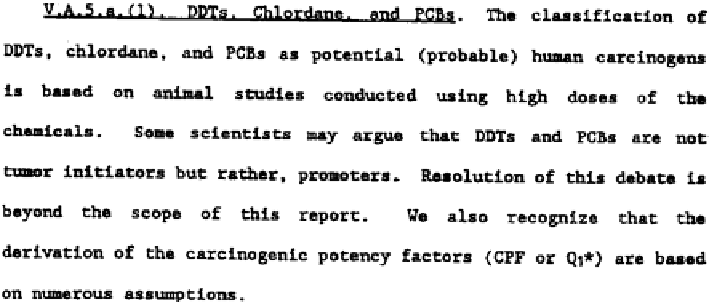Environmental Engineering Reference
In-Depth Information
This latter objective was overlooked by both US EPA and the SARWQCB in
deciding to use the 100 ppb guidance as a TMDL target for total DDT. OEHHA's
objective was to have the total cancer risk for a site, considering multiple species
and chemicals, below a potential lifetime cancer risk of 1/10,000, not necessarily
below a risk of 1/100,000. The 1/100,000 objective was an operational goal by spe-
cies and chemical and was clearly not intended for adoption as a TMDL target.
Considering the levels of chlordane, PCBs and total DDT in fi sh fi llets from Newport
Bay (Allen et al.
2004
), estimates of potential cancer risks are below 1/10,000,
meeting the site objective in the OEHHA guidance. In fact, OEHHA has not issued
a fi sh consumption advisory for Newport Bay.
More recently, OEHHA has revised the fi sh advisory for DDT (Klasing and
Brodberg
2008
). The recommendation is an tissue advisory level of 520 ppb for
DDT. This guidance weighs the cancer and noncancer risks of DDT against the
benefi ts of eating fi sh.
The risk of cancer from exposure to DDTs is inappropriately estimated by
extrapolation of rodent tumor dose-response with the linearized multi-stage model.
This model is intended for use with genotoxic carcinogens. The weight of evidence
indicates that DDTs are not genotoxic. This point is made for DDE in a chapter on
carcinogenesis (Pitot and Dragan
1996
) in the most widely used text in toxicology.
The authors indicated that DDE is not mutagenic and acts as a promoter. This con-
clusion is further explained in a publication from the Pitot laboratory (Holsapple
et al.
2006
) as quoted below.
Mode of action and human relevance of phenobarbital
-
like rodent liver carcinogens
.
Phenobarbital is the prototype of several rodent hapatocarcinogens (e.g., oxazepam, DDT)
that induce tumors by a non-genotoxic mechanism involving liver hyperplasia (Williams
and Whysner, 1996).
The threshold for promotion is orders of magnitude higher than that for a signifi cant
carcinogenic risk estimated by the linearized multistage model. Hence, the linear
extrapolation risk numbers in the OEHHA guidance overestimate the actual cancer
risk. The potential for overestimating the cancer risks is acknowledged in the
OEHHA guidance.

Search WWH ::

Custom Search